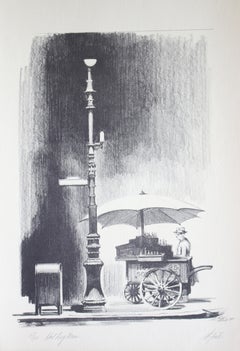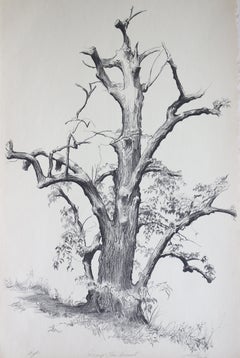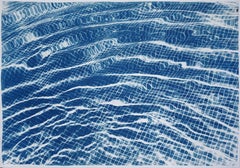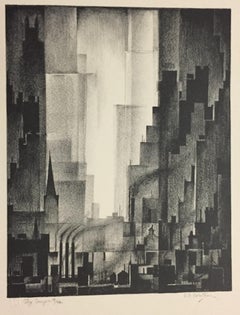Shelly Fink Landscape Prints
American, 1925-2002
Sheldon Fink was born in 1925 in Brooklyn, NY. He attended the High School of Music and Art in Manhattan, and won Tiffany Foundation grants in 1957 and 1963. Shelly's work has appeared at the Albany Art Institute, the Berkshire Art Museum and the Lenox Library in Lenox, Massachusetts, as well as numerous shows in New York City. His work is part of the permanent collections of the Brooklyn Museum of Art and the Metropolitan Museum of Art.to
2
Overall Width
to
Overall Height
to
1
20
169
159
146
130
2
2
2
1
1
2
2
Artist: Shelly Fink
Hot Dog Man ( Edition 67/150)
By Shelly Fink
Located in New York, NY
Shelly (Sheldon) Fink (American, 1925-2002), "Hot Dog Man" Edition 67/150, Figurative/Landscape Lithograph signed on Paper, 17 x 14, Late 20th Century, 1968
Color: Black and White
Sheldon Fink was born in 1925 in Brooklyn, NY. He attended the High School of Music and Art in Manhattan, and won Tiffany Foundation grants in 1957 and 1963. Shelly's work has appeared at the Albany Art Institute, the Berkshire Art...
Category
1960s Abstract Shelly Fink Landscape Prints
Materials
Lithograph
Dying Elm, Vermont (Artist Proof)
By Shelly Fink
Located in New York, NY
Shelly (Sheldon) Fink (American, 1925-2002), "Dying Elm, Vermont" Artist Proof , Landscape Lithograph signed on Paper, 17 x 14, Late 20th Century
Color: Black and White
Sheldon Fink was born in 1925 in Brooklyn, NY. He attended the High School of Music and Art in Manhattan, and won Tiffany Foundation grants in 1957 and 1963. Shelly's work has appeared at the Albany Art Institute, the Berkshire Art...
Category
1960s American Realist Shelly Fink Landscape Prints
Materials
Lithograph
Related Items
Miami Art Deco Pool, Blue Cyanotype on Paper, Abstract Shapes Water Reflections
By Kind of Cyan
Located in Barcelona, ES
This is an exclusive handprinted limited edition cyanotype.
"Miami Art Deco Pool" shows the movements of water over a tiled swimming pool floor.
Details:
+ Title: Miami Art Deco Poo...
Category
2010s Abstract Geometric Shelly Fink Landscape Prints
Materials
Emulsion, Watercolor, Photographic Paper, C Print, Lithograph, Other Medium
Robert N. Robathan, Canyon
Located in New York, NY
Robert N. Robathan was raised in Los Angeles. This lithograph has the blind stamp of the noted California printer, Lynton Kistler, at the lower left.
An impression of this subject i...
Category
Mid-20th Century Abstract Shelly Fink Landscape Prints
Materials
Lithograph
Waves of Clouds, Deep Blue Cyanotype Print, Pleasant Cloudy Sky, Large Triptych
By Kind of Cyan
Located in Barcelona, ES
This series of cyanotype triptychs showcases the beauty of nature scenes, including stunning beaches and oceans, as well as the intricate textures of water, forests, and skies. These triptychs are large pieces that feature lush blues, making them an impressive addition to any beautifully designed space.
Each triptych is printed by hand and carefully crafted to capture the unique essence of these natural environments, with a focus on the interplay of light and shadows, and the subtle nuances of tone and texture.
The beach and ocean scenes depict the dynamic beauty of waves crashing against the shore, with the cyanotype process lending a dreamy, ethereal quality to the images. Similarly, the forest and wood scenes...
Category
2010s American Realist Shelly Fink Landscape Prints
Materials
Lithograph, Rag Paper
$704 Sale Price
20% Off
H 40 in W 83 in
Sun Goddess Flower original lithograph by Salvador Dali
By Salvador Dalí
Located in Paonia, CO
Sun Goddess Flower original signed limited edition lithograph by the great surrealist Salvador Dali. A dynamic and colorful image in greens reds...
Category
1970s Abstract Shelly Fink Landscape Prints
Materials
Lithograph
Provence #7 (Provence France Landscape)
By Roger Mühl
Located in Wilton Manors, FL
Roger Muhl (1929-2008)
Provence #7, 1986. Signed and numbered in pencil by the artist, lower margins.
Artwork is in excellent condition with no damage or conservation.
Frame shows ...
Category
1980s Abstract Shelly Fink Landscape Prints
Materials
Lithograph
$900 Sale Price
25% Off
H 23.5 in W 19.5 in D 1.25 in
Nature Morte country side farming scene
By Maurice Savin
Located in Belgrade, MT
This lithograph is part of my private collection. It is original and pencil signed and numbered by the artist.
Category
20th Century Abstract Expressionist Shelly Fink Landscape Prints
Materials
Engraving, Lithograph
$320 Sale Price
30% Off
H 10.5 in W 7.5 in
Original "1984 Olympics Los Angeles" Torch Runner signed and numbered
Located in Spokane, WA
The Los Angeles Olympics Torch /runner
Original, hand signed and numbered #232/300 "The Olympic Torch Runner". Printed on fine textured paper in 1980 ...
Category
1980s American Realist Shelly Fink Landscape Prints
Materials
Lithograph
$680 Sale Price
20% Off
H 36 in W 22.75 in D 0.05 in
Practice Water Sports, Eastern Block original vintage poster
Located in Spokane, WA
Original poster: Text is in Russian and perhaps Romanian. Archival linen backed in very good condition, ready to frame. The text refers to exercise and to enjoy and participate in various sports in the water. The artist is presumed to be K. Dimitrov, but the poster is not signed nor dated.
The image has a swimmer in the foreground with sailboats, speed boats, and rowing crews in the background. An all-encompassing original water sports lithograph...
Category
1950s American Realist Shelly Fink Landscape Prints
Materials
Lithograph
$798 Sale Price
20% Off
H 39.5 in W 25.75 in D 0.05 in
Labyrinth
By William Crozier
Located in Llanbrynmair, GB
’Labyrinth’
By William Crozier
Medium - Carborundum printmaking, collagraph process
Edition - 47/80
Signed - Yes
Size - 509mm x 407mm
Date - 2007
Condition - Excellent. 10 out of 10....
Category
21st Century and Contemporary Abstract Expressionist Shelly Fink Landscape Prints
Materials
Lithograph, Mezzotint
Street Scene
By Fairfield Porter
Located in New York, NY
Porter's first color lithograph. A very good impression on Arches with strong colors. Signed and numbered 25/100 in pencil. Printed by Mourlot, New York. Published by Brooke Alexande...
Category
1960s Abstract Expressionist Shelly Fink Landscape Prints
Materials
Color, Lithograph
"Winter's Over" barn scene by Owen Wexler
Located in Chesterfield, MI
Winter is serene in this landscape of a barn in winter as it begins to fade and head to spring.
Owen Wexler is the artist; this is a limited edition lithograph signed and titled by him.
Category
Mid-20th Century American Realist Shelly Fink Landscape Prints
Materials
Lithograph
Original "For Your Boy, YMCA, vintage WW1 1918 poster
By Arthur William Brown
Located in Spokane, WA
Original. YMCA for Your Boy. Acid-free original vintage poster in excellent condition with archival linen backing, ready to frame. Certificate o...
Category
1910s American Realist Shelly Fink Landscape Prints
Materials
Lithograph
$620 Sale Price
20% Off
H 30 in W 20 in D 0.05 in
Shelly Fink landscape prints for sale on 1stDibs.
Find a wide variety of authentic Shelly Fink landscape prints available for sale on 1stDibs. You can also browse by medium to find art by Shelly Fink in lithograph and more. Much of the original work by this artist or collective was created during the 1960s and is mostly associated with the abstract style. Not every interior allows for large Shelly Fink landscape prints, so small editions measuring 14 inches across are available. Customers who are interested in this artist might also find the work of Tom Swimm, Armin Landeck, and Charles Bragg. Shelly Fink landscape prints prices can differ depending upon medium, time period and other attributes. On 1stDibs, the price for these items starts at $100 and tops out at $450, while the average work can sell for $275.



